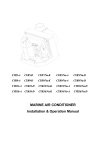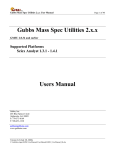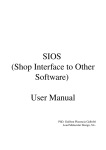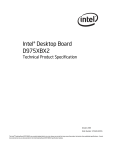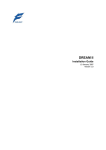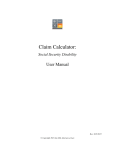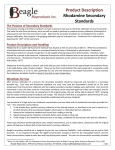Download Cytochrome P450 2D6 (CYP2D6) Inhibitor Screening Kit
Transcript
FOR RESEARCH USE ONLY! Cytochrome P450 2D6 (CYP2D6) Inhibitor Screening Kit (Fluorometric) 7/15 (Catalog # K704-200; 200 Reactions; Store at -20°C) I. Introduction: Cytochrome P450 2D6 (CYP2D6, EC 1.14.14.1) is a member of the cytochrome P450 monooxidase (CYP) family of microsomal xenobiotic metabolism enzymes. CYPs are membrane-bound hemeproteins responsible for Phase I biotransformation reactions, in which lipophilic drugs and other xenobiotic compounds are converted to more hydrophilic products to facilitate excretion from the body. CYP2D6 catalyzes oxidation of lipophilic bases with an aromatic ring and a nitrogen atom and is highly expressed in liver and brain tissue. The enzyme is responsible for metabolism of nearly 25% of all small molecule drugs commonly used by humans, particularly psychiatric drugs such as antidepressants, antipsychotics and stimulants. The CYP2D6 gene is highly polymorphic in the human population, with resulting CYP2D6 activity ranging from complete metabolic deficiency to ultra-rapid metabolism depending upon allelic variation and gene copy number. Due to this wide phenotypic variability, CYP2D6 is frequently implicated in drug toxicity and clinical drug/drug interactions. In addition, for drugs whose pharmacological activity requires metabolism from a pro-drug form, CYP2D6 inhibition or allelic deficiency can lead to decreased drug efficacy. BioVision’s CYP2D6 Inhibitor Screening Kit enables rapid screening of drugs and other new chemical entities (NCEs) for compound-CYP2D6 interaction in a reliable, high-throughput fluorescence-based assay. The kit provides a yeast microsomal preparation of human CYP2D6 and cytochrome P450 reductase (CPR) enzymes. The assay utilizes a non-fluorescent CYP2D6-selective substrate that is converted into a highly fluorescent metabolite detected in the visible range (Ex/Em = 390/468 nm), ensuring a high signal-to-background ratio with little interference by autofluorescence. The kit contains a complete set of reagents sufficient for performing 200 reactions in a 96-well plate format. H2O G6P NADPH Reduced Flavoenzyme Fluorescent Metabolite (λem = 468 nm) 2H NADPH P450 Reductase (CPR) G6PDH 6-PGDL + β-NADP + Cytochrome P450 2D6 (CYP2D6) Oxidized Flavoenzyme Non-fluorescent CYP2D6 Substrate O2 II. Applications: Rapid, high-throughput screening and characterization of drugs and novel ligands for interaction with CYP2D6. Development of structure-activity relationship (SAR) models to predict CYP2D6 inhibition liability of novel compounds and analogues. Prediction of adverse drug-drug interaction potential and bioavailability for compounds metabolized by CYP2D6. III. Kit Contents: Components CYP2D6 Assay Buffer AHMC Standard CYP2D6 Inhibitor (Quinidine) NADPH Generating System (100X) β-NADP+ Stock (100X) CYP2D6 Substrate Recombinant Human CYP2D6 K704-200 Cap Code Part Number 100 ml 1 vial 1 vial 1 vial 1 vial 1 vial 2 vials NM Yellow Amber Green Blue Red Violet K704-200-1 K704-200-2 K704-200-3 K704-200-4 K704-200-5 K704-200-6 K704-200-7 IV. User Supplied Reagents and Equipment: Multiwell fluorescence microplate reader Precision multi-channel pipette and reagent reservoir Anhydrous (reagent grade) acetonitrile and DMSO Opaque white 96-well plates with flat bottom V. Storage Conditions and Reagent Preparation: Store kit at -20°C and protected from light. Briefly centrifuge all small vials prior to opening. Allow the CYP2D6 Assay Buffer to warm to room temperature (RT) prior to use. Read entire protocol before performing the assay procedure. AHMC Standard: Reconstitute in 110 µl of DMSO and vortex until fully dissolved to yield a 2 mM stock solution. The AHMC stock solution should be stored at -20°C and is stable for at least 3 freeze/thaw cycles. CYP2D6 Inhibitor (Quinidine): Reconstitute in 220 µl of acetonitrile and vortex until fully dissolved to yield a 2 mM stock solution. The stock solution is stable for 2 months at -20°C. To obtain a 15 µM working solution of quinidine (5X final concentration), add 15 µl of the 2 mM stock solution to 1985 µl of CYP2D6 Assay Buffer. Store the 15 µM quinidine solution at -20°C and use within one week. NADPH Generating System (100X): Reconstitute with 220 µl CYP2D6 Assay Buffer, aliquot and store at -20°C. Avoid repeated freeze/thaw cycles. Keep on ice while in use. β-NADP+ Stock (100X): Dissolve in 440 µl CYP2D6 Assay Buffer and vortex thoroughly (100X stock). Store at -20°C, stable for at least 3 freeze/thaw cycles. 155 S. Milpitas Blvd., Milpitas, CA 95035 USA | T: (408)493-1800 F: (408)493-1801 | www.biovision.com | [email protected] FOR RESEARCH USE ONLY! CYP2D6 Substrate: Reconstitute with 220 µl anhydrous HPLC-grade acetonitrile and vortex until fully dissolved. Store at -20°C. When using the CYP2D6 Substrate stock solution, allow the vial to warm to RT before opening and promptly retighten cap after use to avoid absorption of airborne moisture. Recombinant Human CYP2D6: The Recombinant Human CYP2D6 should be reconstituted immediately before use as directed in Section VI.2 below. Each vial is sufficient for one 96-well plate. VI. Cytochrome P450 2D6 (CYP2D6) Inhibitor Screening Kit Protocol: 1. Standard Curve Preparation: a. Dilute the AHMC Standard (2 mM stock) by adding 5 µl of the 2 mM solution to 995 µl CYP2D6 Assay Buffer to generate a 10 pmole/µl (10 µM) solution of AHMC. Add 0, 2, 4, 6, 8, 12, 16 and 20 μl of the 10 pmole/µl AHMC standard into a series of wells in an opaque 96-well plate. Adjust the volume of each well to 100 µl with CYP2D6 Assay Buffer, yielding a standard curve with 0, 20, 40, 60, 80, 120, 160 and 200 pmole/well of AHMC. b. Measure fluorescence at Ex/Em = 390/468 nm. Subtract the blank reading (0 nmole/well) from all of the standard readings, plot the background-subtracted values and calculate the slope of the standard curve. 2. Test Compound and CYP2D6 Enzyme Preparation: a. Dissolve test compounds into proper solvent to produce stock solutions (see note regarding solvent effects below). For each test compound, prepare a 5X solution of each desired test concentration by diluting in CYP2D6 Assay Buffer. To determine IC50 values for test compounds, 5X test compound solutions should be prepared in a range of concentrations in order to generate a multi-point dose-response curve. It is also possible to perform a cursory initial screen of a large number of test compounds by observing the percent inhibition at a single fixed concentration of each test compound. In this case, we recommend a final test compound concentration of 3 µM, for which 15 µM solutions (5X final concentration) should be prepared. b. Prepare the Recombinant Human CYP2D6 stock (2X) by reconstituting with 1 ml of CYP2D6 Assay Buffer. Mix contents thoroughly by vortexing to obtain a homogeneous solution and transfer the solution to a 15 ml conical tube. Bring the volume up to 4.9 ml with CYP2D6 Assay Buffer and add 100 µl of the NADPH Generating System (100X) for a final total volume of 5 ml. The CYP2D6 stock is stable for up to 4 hours at room temperature or one day if kept on ice. In order to minimize enzyme instability, we do not recommend long term storage of the reconstituted enzyme system mix. Note: Many commonly-used organic solvents can severely impact CYP2D6 activity. Importantly, DMSO causes significant inhibition of CYP2D6 at final concentrations of ≥0.2% (v/v). We recommend using acetonitrile (final concentration ≤1%; the CYP2D6 Substrate contributes 0.2% acetonitrile to the reaction volume) to dissolve any test ligands, which has been shown to have the least impact on CYP2D6 activity. We recommend preparing a parallel solvent control well with the same final concentration of solvent used to solubilize the test ligands, particularly if using a solvent other than acetonitrile. 3. Reaction Preparation: a. Prepare reaction wells containing test compounds, corresponding no inhibitor controls (which may also serve as a solvent control), background controls (no enzyme) and (if desired) a positive inhibition control using 15 µM quinidine (5X solution): No Inhibitor + Test Compound Background Control Positive Inhibition Control CYP2D6 Enzyme Stock (2X) 50 µl 50 µl — 50 µl Test Compound Solution (5X) — 20 µl — — Quinidine 15 µM Solution (5X) — — — 20 µl CYP2D6 Assay Buffer (+5X Solvent) 20 µl — 70 µl — b. Incubate the plate for 10-15 min at 37°C to allow the test compounds to permeate the microsomal membranes and interact with CYP2D6 in the absence of P450 catalytic turnover. During the incubation, prepare a CYP2D6 Substrate/NADP+ mixture (3X) by adding 20 µl of the reconstituted 2 mM CYP2D6 Substrate stock solution and 100 µl of the reconstituted 5 mM β-NADP+ stock (100X) to 2880 µl of CYP2D6 Assay Buffer for a total volume of 3 ml. This preparation is sufficient for one 96-well plate. c. Start the reaction by adding 30 µl of the CYP2D6 Substrate/NADP+ (3X) mixture to each well using a multichannel pipette, yielding a final reaction volume of 100 µl/well. Notes: To ensure maximal signal intensity, both the pre-incubation period and the P450 reaction itself should be performed at 37°C. The microsomal membranes in the recombinant human CYP2D6 stock may settle at the bottom of the tube over time, so it may be necessary to re-mix to ensure a homogenous solution before dispensing. For no inhibitor/solvent control condition, prepare a small aliquot of CYP2D6 Assay Buffer containing the organic solvent used to dissolve the test compounds at 5X final concentration. During the pre-incubation period, the plate can be pre-read to determine if any test compounds are intrinsically fluorescent. The suggested starting point for the final concentration of CYP2D6 Substrate is 4 µM, which is within 2-fold of the Km for the recombinant CYP2D6 enzyme. This can be optimized by the user depending on the inhibitory potency of their test compounds and the mechanism of inhibition. 4. Measurement: Immediately (within 1 min) measure the fluorescence at Ex/Em = 390/468 nm in kinetic mode for 60 min. While the assay can be performed in either endpoint or kinetic mode, we strongly recommend reading in kinetic mode in order to ensure that the measurements recorded are within the linear range of the reaction. Ideal measurement time for the linear range may vary depending upon the exact reaction temperature and experimental conditions. Note: Since the reaction starts immediately after the addition of the CYP2D6 Substrate/NADP+ mix, it is essential to preconfigure the fluorescence microplate reader settings and use a multichannel pipette with a reagent reservoir to minimize lag time among wells. 5. Calculation: For each reaction well (including background and no inhibitor controls), choose two time points (T1 and T2) in the linear phase of the reaction progress curve, obtain the corresponding fluorescence values at those points (RFU1 and RFU2) and determine 155 S. Milpitas Blvd., Milpitas, CA 95035 USA | T: (408)493-1800 F: (408)493-1801 | www.biovision.com | [email protected] FOR RESEARCH USE ONLY! the rate of change in fluorescence over the time interval: ∆F/∆T = (RFU2 – RFU1) / (T2 – T1). Subtract the rate of the no enzyme/background control (BC) well from the rates of each of the no inhibitor/solvent control (SC) and test compound (TC) wells to determine background-corrected reaction rates (denoted by R) for each well: R= ∆𝑭−∆𝑭𝑩𝑪 ∆𝑻 Calculate the percent inhibition due to the test ligand or positive inhibition control using the following equation: % Relative Inhibition = 𝑹𝑺𝑪 −𝑹𝑻𝑪 𝑹𝑺𝑪 × 100% Notes: In our experience, the CYP2D6 Substrate does not undergo appreciable non-enzymatic conversion to the fluorescent product during the course of a typical assay (60 min). Depending upon instrumental noise, the rate calculation for the no enzyme/background control (BC) well may yield a negative value, in which case, the BC value may be ignored. If desired, reaction rate calculations can also be expressed in terms of pmoles of AHMC formed per unit time per unit amount of protein by interpolation from the standard curve. Each well will contain a total of 60 μg of protein when the recombinant human CYP2D6 is used at the proportions suggested in the kit protocol. (a) (b) 9000 6000 y = 73.975x R² = 0.9985 3000 0 No Inhibitor Quinidine (1 μM) Paroxetine (10 μM) Fluoxetine (60 μM) Dextromethorphan (60 μM) Blank (No Enzyme) 2600 2200 100 Activity (% Solvent Control) 12000 RFU (Ex/Em = 390/468 nm) RFU (Ex/Em = 390/468 nm) (c) 3000 15000 1800 1400 1000 600 40 80 120 160 200 60 Quinidine 40 IC50 = 14.2 1.17 nM Paroxetine IC50 = 746 ± 52.4 nM 20 Fluoxetine IC50 = 4.45 0.13 M Dextromethorphan 200 0 80 0 10 20 30 40 50 0 10-10 IC50 = 3.42 10 0.64 M 10-8 10-7 10-6 10-5 10-4 [Inhibitor] (M) Time (min) AHMC (pmole) -9 Figure: (a) AHMC standard curve. One mole of AHMC corresponds to the metabolism of one mole of CYP2D6 substrate. (b) Reaction kinetics of recombinant human CYP2D6 enzyme at 37°C in the presence and absence of the indicated CYP2D6 inhibitors (the solvent control reaction contained a final concentration of 0.5% acetonitrile). (c) Dose-response curves for various CYP2D6 ligands of differing structural and mechanistic classes: the canonical competitive CYP2D6 inhibitor quinidine (Cat #2910), dextromethorphan (Cat #2912), a prototypical CYP2D6 substrate and the antidepressants fluoxetine and paroxetine (a mechanism-based, irreversible CYP2D6 inhibitor). For dose-response curves, percent activity was calculated for each concentration of inhibitor by comparison to activity of reactions containing no inhibitor. For each CYP2D6 inhibitor, IC50 values were derived by 4-parameter logistic curve fitting with points representing the mean ± SEM of at least three replicate experiments. Assays were performed according to the kit protocol. VII. RELATED PRODUCTS: Microsome Isolation Kit (K249) Cytochrome P450 Reductase Activity Kit (K700) Cytochrome P450 3A4 Activity Assay Kit (K701) Cytochrome P450 3A4 Inhibitor Screening Kit (K702) Cytochrome P450 3A4 (CYP3A4) Human ELISA Kit (K7570) Cytochrome P450 3A4 (CYP3A4) Mouse ELISA Kit (K7571) Cytochrome b5A Human Recombinant (7871) Cytochrome P450 2D6 Activity Assay Kit (K703) Cytochrome P450 2D6, human recombinant (7870) Dextromethorphan HBr (2912) Quinidine Sulfate (2910) AMMC Iodide (2873) Tamoxifen Citrate (1551) FOR RESEARCH USE ONLY! Not to be used on humans. 155 S. Milpitas Blvd., Milpitas, CA 95035 USA | T: (408)493-1800 F: (408)493-1801 | www.biovision.com | [email protected]




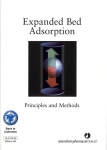

![[PDF:4.7MB]](http://vs1.manualzilla.com/store/data/005740230_1-1ae4d56b6a4c67b9bd1782228090ff43-150x150.png)


